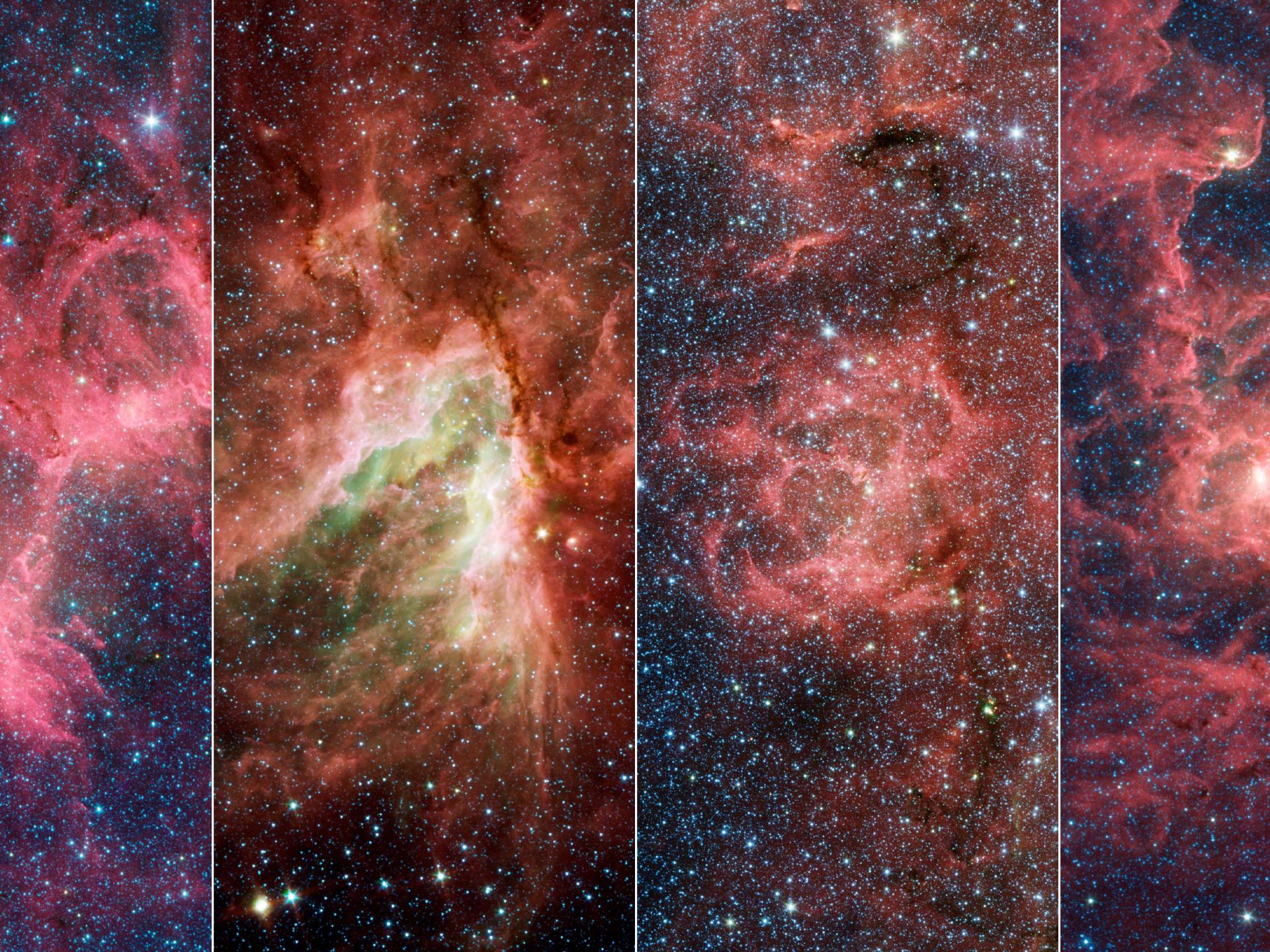A Tourist’s Guide to the Milky Way
In this streamlined article from New Scientist, we journey to seven remarkable landmarks within our galaxy, which have puzzled scientists for decades and opened doors for further scientific exploration that seems to have no end.
S1 Stream—a Stellar Parade of Dark Matter
Let’s begin our cosmic voyage by jumping into a river of stars flowing right through our galaxy and stretching across the entire Milky Way, known as the “S1 Stream.” To grasp the scale of this stream, think thousands of light-years in length and width. Imagine our solar system—nestled within this stellar river—as a grain of sand in the Amazon River.
To trace the origin of this collection of stars or the S1 Stream, we must rewind nearly 9 billion years into our galaxy’s youth. As we peer into the Milky Way at that time, we discover it was surrounded by a swarm of “dwarf galaxies” orbiting it.
However, when one of these dwarf galaxies ventures too close and gets gravitationally bound to the Milky Way, it falls victim to our galaxy’s cannibalistic appetite (in an event called galactic mergers).
But despite the unfortunate fate of the dwarf galaxy, its individual stars continued their journey through the Milky Way’s interstellar medium, which is mostly empty space between stars. Even today, this extended stream of stars remains visible and distinct.
Now, let’s shift our focus to one of the greatest enigmas in physics—dark matter. Researchers are enticed to think that a journey through the S1 Stream may offer an opportunity to solve this perplexing puzzle. For decades, scientists have inferred the existence of dark matter based on observations of galaxy motions that were moving faster than expected, leading them to conclude that these galaxies must contain more unseen mass.
However, similar measurements of the motions of stars indicate that dwarf galaxies are unusually rich in dark matter, prompting the suggestion that the S1 Stream is essentially a river of dark matter flowing right through our solar system.
While studies suggest our best chance of detecting dark matter—if it takes the form of theorized lightweight particles called “axions”—lies in future satellite experiments, we can also do it from the ground.
Proxima Centauri b—Earth’s Doppelganger
To date, scientists have discovered over 5,000 exoplanets, or planets outside our solar system, orbiting other stars in our Milky Way galaxy. However, there are still many billions more worlds out there waiting to be explored within our galaxy.
If we had the chance to visit any of these exoplanets, we would want to choose one with a promising chance of supporting life on its surface. Because we simply don’t know whether life can arise under conditions vastly different from those on Earth, nor the kind of environments that can form in these planetary systems, our safest bet would be a planet that closely resembles our own.
Last year, the James Webb Space Telescope (JWST) detected tantalizing signs of carbon dioxide, methane, and water vapor in the atmospheres of distant exoplanets. However, the planet we’ll discuss is an Earth-like planet known as “Proxima Centauri b,” which orbits the closest star to the Sun.
While we still don’t know the surface conditions of this world, we do know its parent star is a red dwarf that’s just one-eighth the mass of the Sun and emits about 1,000 times less light, making it quite faint. The planet is fortunate that if it were orbiting a Sun-like star, it would be scorched, but the conditions around it make it a promising candidate for habitability.
Based on the energy the planet receives from its parent star (a relatively cool red dwarf), Proxima Centauri b’s equilibrium temperature is estimated to be around -39 degrees Celsius. However, if the planet has an atmosphere of sufficient mass, a runaway greenhouse effect could make it much warmer and potentially more hospitable to life.
If we peek into its atmosphere, and make assumptions about the type of air it’s made up of, we’re presented with a spectrum of possibilities, ranging from Proxima Centauri b being a warm, water-covered world to being a frozen ball of ice.
Now, if you’re wondering about the power of atmospheres to transform planetary conditions, Earth’s equilibrium temperature is around -20 degrees Celsius (or -1 degrees Fahrenheit), which is perfect for life to flourish, thanks to the gases that envelop our planet—at least for now.
A quick glance at the clouds or oceans might indicate the potential for life beneath the surface of this alien world. Yet even if this planet is barren and devoid of any life forms, I can at least guarantee you the most breathtaking sunset vista in the Milky Way.
Proxima Centauri b orbits its parent star every 11 days and is tidally locked, meaning one side of the planet always faces the star while the other side perpetually faces away. As a result, one side of the planet experiences perpetual daylight while the other is shrouded in eternal night. In between lies the twilight zone, a boundary between the lit and dark sides of the planet known as the “terminator.”
Within this liminal zone, high-speed winds blow from the scorching regions to the freezing ones. If we could withstand these conditions, we would be treated to an utterly bizarre sight: a sunset that perpetually hangs in the sky.
Betelgeuse—a Stellar Time Bomb
Our next destination is a massive star, ageing and bloated, outshining our Sun by a factor of about 100,000. Many of us have probably seen it at some point, glowing a deep red in the cold winter sky, marking one of the vertices of the constellation Orion (the most recognizable constellation in the night sky).
Currently, this star is incredibly unstable, hinting that it could explode as a supernova at any moment (a supernova is an astronomical event that occurs during the last stages of a massive star’s life, when it undergoes a catastrophic explosion that ejects its envelope of gas into space at the end of its life).
Known as Betelgeuse, this giant star is one of the largest in the Universe, so vast that it could swallow up hundreds of millions of Suns like our own. Were this star at the center of our solar system, it would engulf Mercury, Venus, Earth, Mars, and come close to consuming Jupiter as well.
Its immense size is partly due to the fact that it was born big, but the main reason is that it has reached the końcowe stages of its life and has expanded into a red giant. After exhausting the hydrogen fuel that powers nuclear fusion in our Sun, Betelgeuse begins to burn helium, releasing much more energy than the fusion of hydrogen nuclei, causing the star to expand and balloon from within.
On the other hand, the current behavior of Betelgeuse suggests that the star’s life is nearing its end, as there’s typically only a finite amount of helium to sustain a star for a few million years. Once that runs out, the star begins to burn progressively heavier elements in a rapid and desperate fashion, like a desperate ship’s captain stripping away floorboards to feed the furnace.
So, the star may burn carbon for hundreds of years, then oxygen for six months, and on its final day, it will burn silicon before nuclear fusion ceases altogether.
At that point, the star’s own gravity overwhelms it, causing the star to collapse inward under its own weight. That is, the force of gravity starts pulling the star’s outer material towards its center, and this infalling mass crushes down on the star’s dense core, causing the star to implode with immense speed, approaching the speed of light.
And when the infalling material hits the star’s core, it rebounds in the form of a shock wave that outshines billions of stars—an event known as a “supernova.”
For years, astronomers have been closely monitoring Betelgeuse, eager to learn how far along it is in this process and how much longer it has before it reaches its end. Earlier this year, astronomers used computer simulations and mathematical models to understand how Betelgeuse oscillates between bright and dim over time. And from this, they concluded that the star is currently in the late stages of burning carbon, meaning the explosion could occur within centuries, while other astronomers believe this dimming is caused by plumes of dust the dying star is throwing off around it. In that case, Betelgeuse may have hundreds of thousands of years before it explodes.
A close flyby of this star would tell us what’s really going on. We might secure ourselves a front-row seat to one of the most spectacular fireworks displays in the Universe. Before our very eyes, streams of color would cascade from the star’s outer layers in a prelude to the final show.
However, make sure your travel insurance is up to date because supernova explosions are extremely violent events. Even if we were observing the star from Earth, the display would outshine the full Moon for weeks on end.



